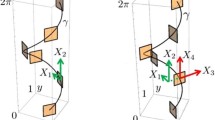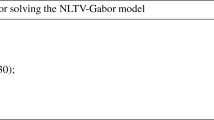Abstract
The so-called “simple cells” in layer IV of feline primary visual cortex have been shown to have Gabor function spatial receptive field profiles (RFP's). Since Gabor functions are not mutually orthogonal, the decomposition of an image into Gabor function coefficients is usually performed by minimising some measure of the error between the original image and that reconstructed from the coefficients. A cortical relaxation model is proposed which performs this minimisation implicitly, and is used to examine the biological relevance and feasibility of reconstruction error minimisation.
Similar content being viewed by others
References
Barlow HB (1961) Possible principles underlying the transformations of sensory messages. In Rosenblith WA (ed) Sensory communication. MIT Press, Cambridge
Daugman JG (1988) Complete discrete 2-D Gabor transforms by neural networks for image analysis and compression. IEEE Trans Acoust Speech Signal Process 36:1169–1179
Földiák P (1989) Adaptive network for optimal linear feature extraction. Proc IEEE Int Conf Neural Networks 1:401–405
Hebb DO (1949) The organisation of behaviour. Wiley, New York
Jones JP, Palmer LA (1987a) An evaluation of the two-dimensional Gabor filter model of simple receptive fields in cat striate cortex. J Neurophys 58:1233–1258
Jones JP, Palmer LA (1987b) The two-dimensional spatial structure of simple receptive fields in cat striate cortex. J Neurophys 58:1187–1211
Leung M-T, Engeler W, Frank P (1990) Fingerprint processing using back-propagation neural networks. Int Joint Conf Neural Networks I:15–20
Linsker R (1990) Perceptual neural organization: Some approaches based on network models and information theory. Ann Rev Neurosci 13:257–81
Porat M, Zeevi YY (1988) The generalized Gabor scheme of image representation in biological and machine vision. IEEE Trans Pattern Anal Machine Intell 10:452–468
Rubner J, Tavan P (1989) A self-organizing network for principal component analysis. Europhys Lett 10:693–98
Stratford K, Mason A, Larkman A, Major G, Jack J (1989) The modelling of pyramidal neurones in the visual cortex. In: Durbin R, Miall C, Mitchinson G (eds) The computing neuron. Addison-Wesley, Reading Mass, pp 296–321
Wörgötter F, Koch C (1991) A detailed model of the primary visual pathway in the cat: comparison of afferent excitatory and intracortical inhibitory connection schemes for orientation selectivity. J Neurosci 11:1959–1979
Yan H (1991) Image compression using Hopfield neural networks. In: Proc Second Australian Conf Neural Networks, pp 267–270
Author information
Authors and Affiliations
Rights and permissions
About this article
Cite this article
Pattison, T.R. Relaxation network for Gabor image decomposition. Biol. Cybern. 67, 97–102 (1992). https://doi.org/10.1007/BF00201806
Received:
Accepted:
Issue Date:
DOI: https://doi.org/10.1007/BF00201806




